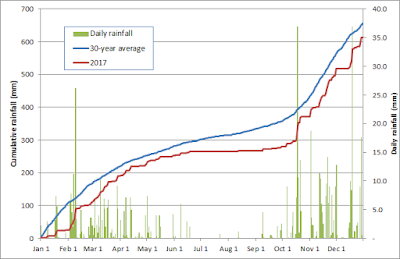Victoria received 186 mm of rain during the September to November period at Victoria Gonzales. That's about 18% less than the 30-year average fall rainfall of 226 mm. Rainfall was actually a bit above normal in September (28 mm in 2018 vs. the average 24 mm). However, this was followed by a drier than average October (50 mm vs. 72 mm) and November (108 mm vs. 130 mm).
There were 39 days with measurable precipitation this fall, with 11 days in September, 13 days in October, and 15 days in November. That's actually slightly above the 37 days with measurable rainfall that Victoria typically receives during the fall (7 days in September, 12 days in October, and 19 days in November).
The chart below shows daily rainfall during fall 2018, and compares the cumulative rainfall with the 30-year average. September and early October were slightly wetter than normal. This was followed by a two-week dry spell during the middle of October. The end of October and beginning of November was the wettest period of the fall, with nearly half of Victoria's fall rainfall this year being recorded over a 9-day stretch from October 27 to November 4. This period included the wettest single day of the fall: 19.6 mm on November 1. The remainder of November was a little drier than normal.
 |
| Daily & Cumulative Rainfall in Victoria, Fall 2018 |
 |
| Fall 2018 Rainfall |
The chart below shows the daily maximum and minimum temperatures at Victoria Gonzales during fall 2018, compared with the 30-year averages. You can see that September was generally a bit cooler than average, while October and November were both a bit warmer than average. The warmest day of the fall was 23.3 degrees on September 5, although it also reached 23.1 degrees on September 28, which was a greater anomaly from the average (which is 17.5 degrees for that date). The coolest temperature was 2.7 degrees on November 19.
 |
| Daily Max & Min Temperatures in Victoria, Fall 2018 |



























